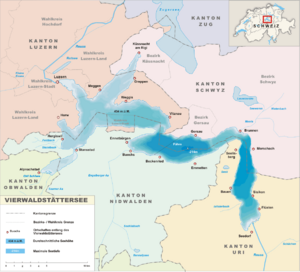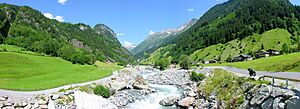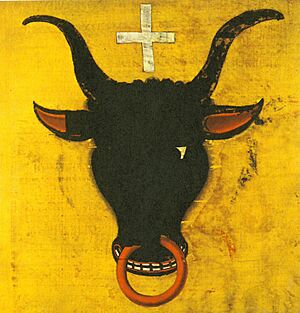Canton of Uri facts for kids
Quick facts for kids
Canton of Uri
Kanton Uri (German)
|
|||||
|---|---|---|---|---|---|
|
|||||
| Capital | Altdorf | ||||
| Subdivisions | 19 municipalities | ||||
| Area | |||||
| • Total | 1,076.56 km2 (415.66 sq mi) | ||||
| Population
(December 2020)
|
|||||
| • Total | 36,819 | ||||
| • Density | 34.2006/km2 (88.5792/sq mi) | ||||
| Demonym(s) | Urner | ||||
| GDP | |||||
| • Total | CHF 1.985 billion (2020) | ||||
| • Per capita | CHF 54,006 (2020) | ||||
| ISO 3166 code | CH-UR | ||||
| Highest point | 3,630 m (11,909 ft): Dammastock | ||||
| Lowest point | 434 m (1,424 ft): Lake Lucerne | ||||
| Joined | 1291 | ||||
| Languages | German | ||||
The canton of Uri is one of the 26 cantons of Switzerland. It was one of the first members of the Swiss Confederation. Uri is located in Central Switzerland. Its land covers the valley of the Reuss river. This valley stretches between the St. Gotthard Pass and Lake Lucerne.
The official language in Uri is German. However, most people speak a local Swiss German dialect. This dialect is called Urnerdeutsch.
Uri used to teach Italian as the first foreign language in schools. But in 2005/2006, this changed to English. This change made Uri similar to other cantons in Central and Northeastern Switzerland. The canton has about 35,000 people living there. About 8.7% of them are from other countries.
The famous William Tell is said to have come from Uri. The historic place called Rütli is also located in the canton of Uri.
Contents
What Does the Name "Uri" Mean?
The name of the valley, Uronia, was first written down in the 8th or 9th century. In the Middle Ages, "Uri" only referred to Altdorf and the areas around it. The name started to cover a larger area as the canton grew in the 15th century.
The German name Ure(n) was used from the 13th century. The modern name Uri began in the 16th century. The name might come from a Latin word meaning "edge" or "shore." This would refer to the Reuss river or Lake Lucerne.
There's also a popular story that the name comes from ûr. This is the German name for the aurochs, a type of wild bull. This idea might be why the canton's seal, which shows a bull's head, was created in the 13th century.
A Look at Uri's History
How Uri Began
People have lived in Uri since the Bronze and Iron Ages. They traded goods across the Alps. During the Roman times, Uri was quite isolated. Later, people from a group called the Alemanni settled here in the 7th century.
In 853, Uri was given to a church in Zürich. Uri briefly came under the rule of the Habsburg family in 1218. The Gotthard Pass opened in 1230. This pass was a very important trade route. Uri then gained special rights from the Holy Roman Emperor in 1231. This meant Uri was directly under the emperor, not a local lord.
Trade through the Gotthard Pass made Uri richer. The towns along the route became more independent. By 1243, Uri had its own seal with a bull's head.
Joining the Swiss Confederation
Uri made a special agreement with Schwyz in 1291. This agreement is seen as the start of the Old Swiss Confederacy. In 1315, the Swiss won the Battle of Morgarten. This was an important victory against the Habsburgs. After this, the three original cantons confirmed their alliance.
Over the next decades, the Confederacy grew. They became a strong power in the region. They defeated the Habsburgs again in the Battle of Sempach in 1386. This allowed the Confederacy to expand even more.
After the victory at Sempach, Uri started to expand its own territory. They wanted to control the entire Gotthard route. In 1410, Uri took over the Urseren valley. The people there were allowed to keep their own local government. Uri also gained control of areas south of the Alps, like the Leventina valley. This led to conflicts with the Duke of Milan. The Swiss captured Bellinzona in 1500. However, their expansion ended after a defeat in 1515.
Uri, like other central Swiss cantons, stayed Roman Catholic during the Swiss Reformation. They formed an alliance with Austria to protect their religion. After a battle in 1531, a peace treaty was signed. It allowed each canton to choose its own religion.
Life in Uri was tough in the early modern period. There wasn't much farmland. Diseases like the Plague broke out often. Crop failures also led to hunger and people leaving the canton. By the end of the 18th century, Uri's population had actually decreased.
Uri in Modern Times
The government of Uri did not like the ideas of the French Revolution. In 1798, French forces invaded Switzerland. Uri had to accept a new constitution. It became part of a larger canton called Waldstätten. Uri also lost its lands south of the Gotthard Pass.
In 1799, there was fighting in Uri between French troops and other armies. A large fire destroyed much of Altdorf in 1799. These events caused a famine in Uri. It took many years for Uri to recover. In 1801, Uri became a canton again.
After Napoleon's rule ended in 1813, Uri regained its full independence. In 1815, the canton approved the new federal constitution for Switzerland.
Uri remained very traditional. In the 1840s, some cantons wanted more liberal changes. Seven conservative, Catholic cantons, including Uri, formed a separate alliance called the Sonderbund. In 1847, the Sonderbund War broke out. Uri sent troops to fight. After the Sonderbund was defeated, Uri surrendered.
After the war, Uri supported the new Swiss Federal Constitution. They also created their own cantonal constitution. This new constitution brought some liberal changes. The Landsgemeinde, a traditional open-air assembly where people voted by raising hands, continued locally. The last one was held in 1928.
Today, the Christian Democratic Party (CVP) and the Free Democratic Party (FDP) have been the main political parties in Uri.
Where is Uri?
The canton of Uri is in the middle of Switzerland. It is on the north side of the Swiss Alps. The land of Uri is mostly the valley of the Reuss river. It also includes the valleys of smaller rivers that flow into the Reuss.
Uri covers about 1,076 square kilometers (415 square miles). About 24.4% of this land is used for farming. Forests cover 18.2% of the canton. Only 1.7% of the land has buildings or roads. More than half (55.6%) of the land is unproductive, like mountains and glaciers.
The highest point in Uri is the Dammastock mountain. It is 3,630 meters (11,909 feet) tall. Parts of the Glarus Alps and Lepontine Alps are also in Uri.
Towns and Villages
Uri has 19 self-governing towns and villages. The capital city of the canton is Altdorf.
The municipalities of Uri are:
- Altdorf
- Andermatt
- Attinghausen
- Bürglen
- Erstfeld
- Flüelen
- Göschenen
- Gurtnellen
- Hospental
- Isenthal
- Realp
- Schattdorf
- Seedorf
- Seelisberg
- Silenen
- Sisikon
- Spiringen
- Unterschächen
- Wassen
On January 1, 2021, the village of Bauen joined the municipality of Seedorf.
Uri's Flag and Coat of Arms
The coat of arms for Uri shows a black bull's head on a yellow background. The bull has a red tongue and a nose ring.
The bull's head might be linked to the popular story about the name "Uri" coming from the word for aurochs (wild bull). This symbol has been used since the 13th century. By the 14th century, Uri used a flag with a black bull's head on a yellow field.
Old flags from Uri are kept in the town hall of Altdorf. These flags are said to be from important battles in Swiss history.
People of Uri
Uri has a population of about 37,317 people. As of 2010, about 9.4% of the people living in Uri were foreign nationals. Over the last 10 years, the population has stayed mostly the same.
Most people in Uri speak German as their first language. About 93.5% of the population spoke German in 2000. Serbo-Croatian was the second most common language, followed by Italian.
In 2000, about 47.4% of the people in Uri were born there. About 26.2% were born in another part of Uri. Another 15.6% were born elsewhere in Switzerland. About 8.7% were born outside of Switzerland.
Children and teenagers (0–19 years old) make up 25% of the population. Adults (20–64 years old) are 58.6%. Seniors (over 64 years old) make up 16.4%.
Religion in Uri
In 2000, most people in Uri were Roman Catholic (85.8%). About 5.2% belonged to the Swiss Reformed Church (Protestant). There were also some members of Orthodox churches and other Christian churches. A small number of people were Muslim, Buddhist, or Hindu. About 2.35% of the population did not belong to any church.
Learning and Education
About 34.4% of Uri's population has finished high school. About 8.0% have gone on to higher education, like university. Of those with higher education, most were Swiss men.
Uri's Economy
The farms in Uri are mainly in the Reuss valley. There are also pastures on the lower mountain slopes. Much of the land is very hilly, so it's not good for growing crops.
Generating electricity from water (hydroelectric power) is very important in Uri. Forestry, which means managing forests and cutting wood, is also a key part of agriculture. In Altdorf, there are factories that make cables and rubber products.
Tourism is a big part of Uri's economy. There are many roads that make it easy for tourists to visit the mountains.
In 2010, Uri had a low unemployment rate of 1.4%. In 2008, many people worked in farming, manufacturing, and services like hotels and healthcare.
Tourism in Uri
Uri has 39 cable cars. These cable cars help people reach mountain peaks. They also lead to many hiking and biking trails. In winter, they provide access to ski slopes and cross-country tracks.
Tourism is a major industry in Uri. In 2008, there were 91 hotels in the canton. These hotels had 1,368 rooms. That year, 145,600 guests stayed in these hotels. About 67.1% of these guests were from outside Switzerland.
How Uri is Governed
Federal Elections
In the 2015 federal election, the most popular party in Uri was the SVP/UDC. They received 44.1% of the votes. The CVP/PDC/PPD/PCD was next with 26.8%. The GPS/PES received 26.3% of the votes.
Cantonal Elections
Uri has a local parliament called the Landrat. In the last election on March 8, 2020, the Christian Democrats (CVP) remained the largest party. They gained three seats and now have 25 seats.
The FDP.The Liberals are the second largest party with 16 seats. The Swiss People's Party is the third strongest. The Social Democratic and Green parties work together. They kept their 9 seats and are the smallest group in the Landrat.
Images for kids
See also
 In Spanish: Cantón de Uri para niños
In Spanish: Cantón de Uri para niños








